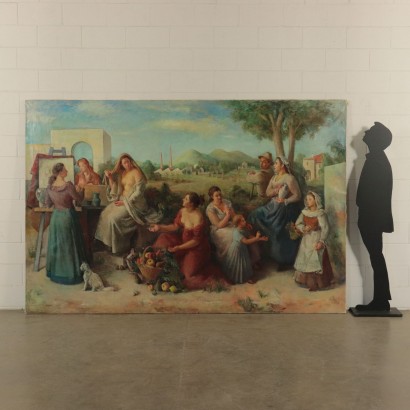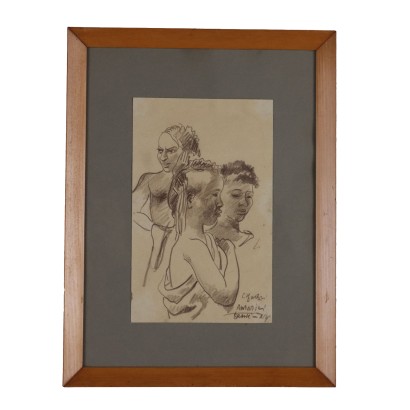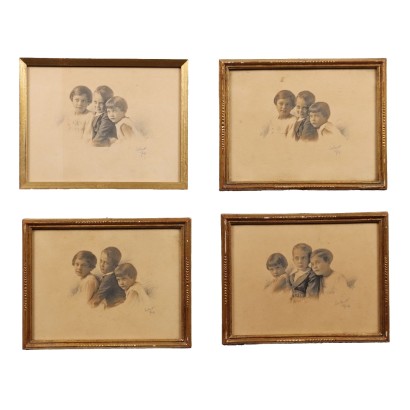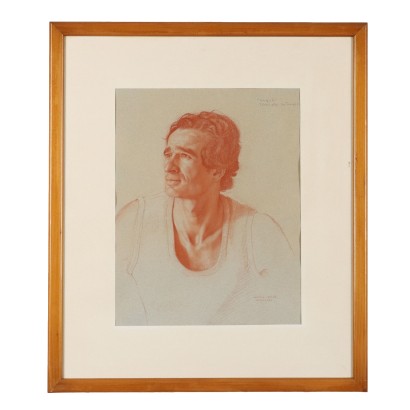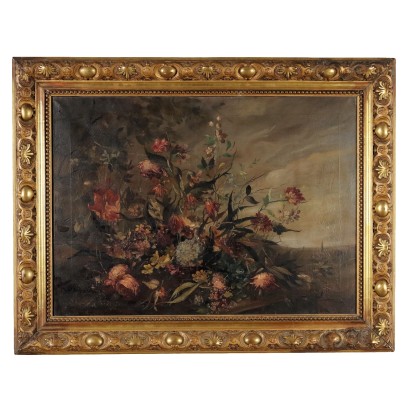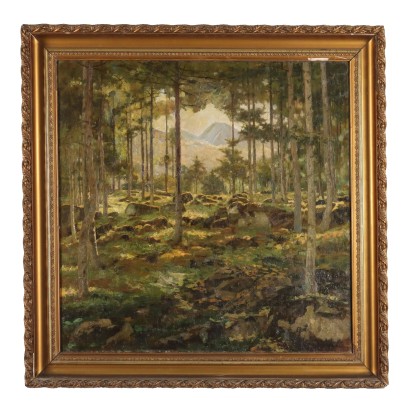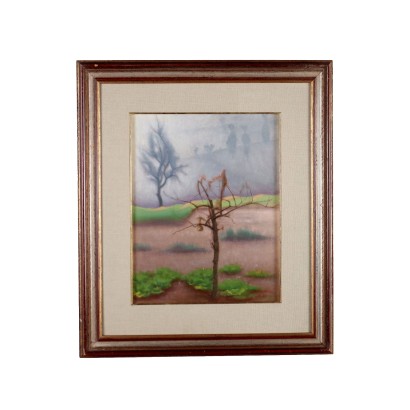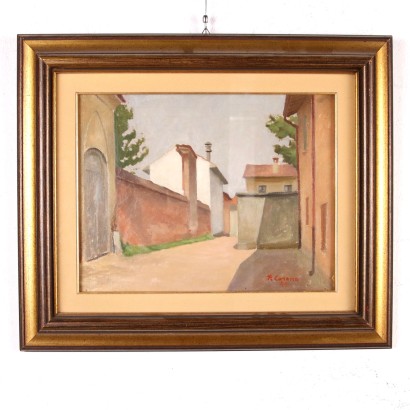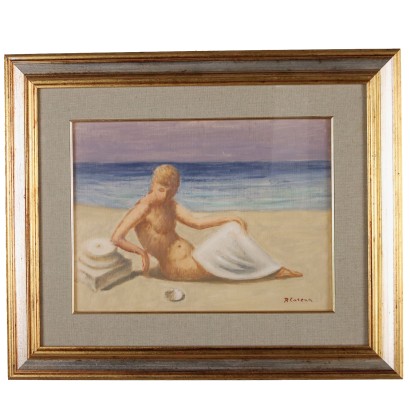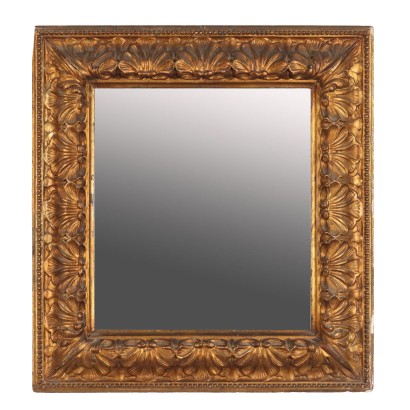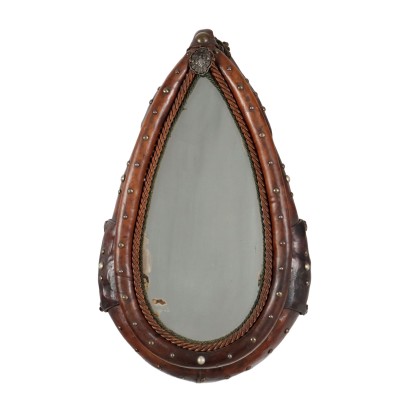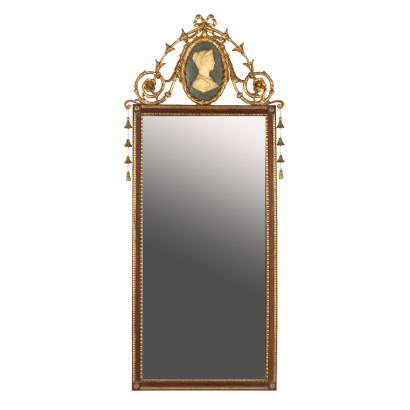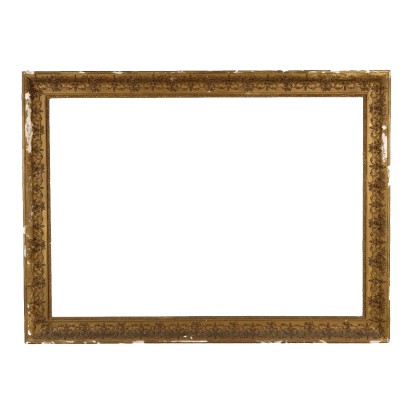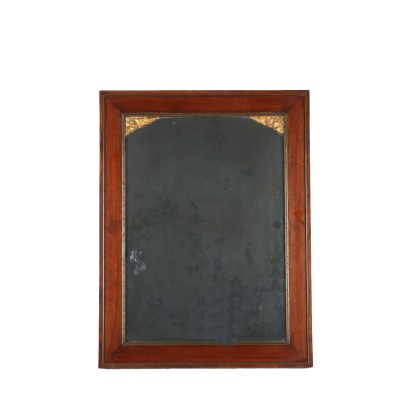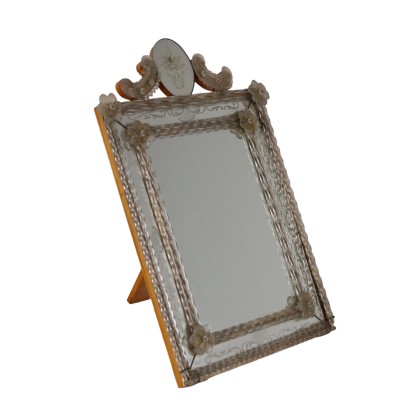Contemporary Painting C. Barbieri Female Work Italy 1954 ca. - Large Painting, 1954 ca.
Features
Large Painting, 1954 ca.
Artist: Contardo Barbieri (1900-1966)
Artwork title: Il Lavoro Femminile
Age: 20th Century / 1901 - 2000
Subject: Human Figures
Origin: Italy
Artistic technique: Painting
Technical specification: Oil on Canvas
Description : Il Lavoro Femminile
In the foreground, a group of female figures is depicted, in which there is only one male figure, however relegated to the background. On the right are two girls facing each other, the one further away is drawing, while the one seen from behind, at whose feet a cat is sitting, is intent on painting on a canvas placed on an easel. He is observing the model to be portrayed: two young girls dressed in old-fashioned clothes, one seated, semi-dressed in a long white cloak which also covers her head and her partner, kneeling in front of a basket full of fruit and vegetables. Alongside another small group, more heterogeneous. A young woman dressed in white is watching a little girl who seems to be running towards the girl on the far right, dressed in country clothes and carrying a basket of fruit under her arm. Among these, leaning against a tree, there is a woman also dressed in a peasant style who holds a small skin in her hands, next to her the only male figure supports himself on a shepherd's stick. In the background a natural landscape with a hilly profile, dotted with trees, but also with characters caught in rural activities such as harvesting and sowing. Immersed in nature there are also rural houses, but also industrial buildings with tall chimneys and more modern constructions, such as the mighty arch, which almost acts as an architectural backdrop on the left of the painting. Signed “C. Barbers” on the right.
Product Condition:
Product in very good condition which may show slight traces of wear; it may have undergone restoration work carried out by an expert. We try to present the real state as fully as possible with photos. If some details are not clear from the photos, what is reported in the description will prevail.
Artwork dimensions (cm):
Height: 212
Width: 312
Depth: 4
Additional Information
Artist: Contardo Barbieri (1900-1966)
Born in Broni (PV) in 1900, Contardo Barbieri graduated from the Brera Academy of Arts in 1921. Without abandoning the realist matrix of his initial painting, during the 1920s Contardo Barbieri achieved a more solid and synthetic rendering of forms on the suggestion of the contemporary research of the Novecento group, which he joined after the first Milanese exhibition in 1926. From his debut in 1927 at the "National Art Exhibition", set up at the Palazzo della Permanente in Milan, he participated in numerous exhibitions, exhibiting between 1928 and 1942 at eight editions of the Venice Biennale and from 1931 to 1943 at four Quadrennials of Rome. In 1931 he also exhibited at the Baltimore Museum of Art and the Cleveland Museum of Art, in the United States, as part of the Exhibition of contemporary Italian paintings, organized by the Quadriennale. He obtained numerous awards, such as the International City of Venice Award at the 17th Biennale and the National Fascist Party Award at the 19th Biennale, with a vast repertoire of portraits, female figures, still lifes, as well as landscapes, in which he combined the severe twentieth-century language with I study from life. He was appointed director of the Carrara Academy in Bergamo in 1931 and, as part of the cultural renewal of the city, he created a mural decoration for the Littoria "A. Locatelli" house in 1938, which was later destroyed. In the mid-1930s he left as a volunteer for East Africa. Coinciding with the failure of the fascist ideology, an artistic crisis matured which culminated in 1942, with the retreat to models and schemes derived from ancient art. Barbieri died in Milan in 1966.Age: 20th Century / 1901 - 2000
20th Century / 1901 - 2000Subject: Human Figures
Artistic technique: Painting
La pittura è l'arte che consiste nell'applicare dei pigmenti a un supporto come la carta, la tela, la seta, la ceramica, il legno, il vetro o un muro. Essendo i pigmenti essenzialmente solidi, è necessario utilizzare un legante, che li porti a uno stadio liquido, più fluido o più denso, e un collante, che permetta l'adesione duratura al supporto. Chi dipinge è detto pittore o pittrice. Il risultato è un'immagine che, a seconda delle intenzioni dell'autore, esprime la sua percezione del mondo o una libera associazione di forme o un qualsiasi altro significato, a seconda della sua creatività, del suo gusto estetico e di quello della società di cui fa parte.Technical specification: Oil on Canvas
The oil painting is a painting technique using powder pigments mixed with bases in inert and oils.Other customers have searched:
Arte Novecento, dipinti del 900, olio su tavola, pittura olio su tela, arte 800, pittura antica, arte contemporanea, quadro del '900, quadro grande, quadro olio su tela..
Se sei un appassionato d'arte, non perderti i nostri approfondimenti sul Blog Arte Di Mano in Mano e su FineArt by Di Mano in Mano - Arte:
Leggi di più
Ecco alcuni tra i principali articoli:
Vedute
Falsi nell'arte antica
Un messaggio di fiducia per ripartire
La potenza espressiva dell'arte figurativa etiope
Breve Storia del Collezionismo
Giorgio Upiglio, maestro dei libri d'artista
Matthias Withoos detto "Calzetta bianca"
San Rocco pensaci tu - Classic Monday
Ecco alcuni esempi dell'arte del Novecento più bella che puoi trovare da noi:
I Raccoglitori di patate - Lavoro estivo - Augusto Colombo, 1935
I Taglialegna - Lavoro invernale - Augusto Colombo, 1933
Il lavoro femminile, Contardo Barbieri, 1954 ca.
Sapevi che l'arte può essere anche un ottimo investimento (e non solo per grandi portafogli)?
L'Arte tra Collezionismo e Investimento
FineArt: Arte come investimento
Dai un'occhiata alle nostre rubriche di divulgazione sull'arte:
Epoche
Lavorazioni e tecniche
Mostre ed Eventi
Protagonisti
Leggi di più
Ecco alcuni tra i principali articoli:Vedute
Falsi nell'arte antica
Un messaggio di fiducia per ripartire
La potenza espressiva dell'arte figurativa etiope
Breve Storia del Collezionismo
Giorgio Upiglio, maestro dei libri d'artista
Matthias Withoos detto "Calzetta bianca"
San Rocco pensaci tu - Classic Monday
Ecco alcuni esempi dell'arte del Novecento più bella che puoi trovare da noi:
I Raccoglitori di patate - Lavoro estivo - Augusto Colombo, 1935
I Taglialegna - Lavoro invernale - Augusto Colombo, 1933
Il lavoro femminile, Contardo Barbieri, 1954 ca.
Sapevi che l'arte può essere anche un ottimo investimento (e non solo per grandi portafogli)?
L'Arte tra Collezionismo e Investimento
FineArt: Arte come investimento
Dai un'occhiata alle nostre rubriche di divulgazione sull'arte:
Epoche
Lavorazioni e tecniche
Mostre ed Eventi
Protagonisti




